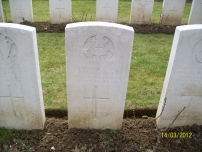| First Name: | Edward Thomas | Last Name: | BRUNIGE | |
|---|---|---|---|---|
| Date of Death: | 03/09/1916 | Lived/Born In: | Stroud Green | |
| Rank: | Private | Unit: | Sussex11 | |
| Memorial Site: | ||||
Current Information:37, Ridge Road, Stroud Green Born-Barnsbury Ancre British Cemetery, Beaumont-Hamel, Somme
The Battle of the Somme (July-November, 1916) By the beginning of September, 1916, the Battle of the Somme had been raging for two months. Thousands of men had already been killed or wounded or were simply missing, never to be seen again and and just a few square miles of the French countryside, all in the southern part of the battlefield, had been captured from the enemy. Mistakes had been made by the various commanders and would be continued to be made but there was no turning back as the British, Australians, South Africans, New Zealanders and Canadians carried on battering away at the German defences in the hope of a breakthrough, So it continued all the way through to November with nearly every battalion and division then in France being drawn into it at some stage. In the end the German trenches had been pushed back a few more miles along most of the line but the cost in lives had been staggering. By the end of the fighting in November, 1916, British Army casualties numbered over 400,000, killed, wounded and missing. On 3rd September, 1916, the same day that the village of Guillemont finally fell to the British Army, there was another attack further north on the Somme battlefield, astride the River Ancre, a sector that had been largely inactive ever since the disasters of 1st July. 39th Division attacked along the north of the Ancre to secure a few hundred yards of high ground west-north-west of St Pierre-Divion in order to cover the flank of 49th Division attacking up the Ancre and to the south of it. Like so many other actions the British artillery barrage that preceded the attack left too much wire uncut and too many German machine gun nests and dug-outs intact. Add to this the power and the accuracy of the enemy artillery and the weak and exhausted state of the battalions involved and it becomes clear why the attack, despite great gallantry and repeated efforts, came to grief. 116 Brigade attacked in the centre of 39th Division with the 11th Sussex and 14th Hampshire battalions. Zero hour was 5.10am and both battalions made good progress initially with the help of a machine-gun barrage fired over their heads which dealt with the Germans on their parapet, but the succeeding waves were hard hit by artillery fire as they crossed no-man’s-land. The first two enemy lines were soon taken but then resistance stiffened. On their left 117 Brigade had been less successful and their failure to keep apace meant that the flank of 116 Brigade was uncovered and 14th Hampshire’s advance was halted. However, 11th Sussex fared better and managed to get into parts of the enemy support trench. By now the losses were beginning to mount up and as the attack on the other side of the Ancre had failed, reinforcements and ammunition were prevented from coming up. Artillery fire from St. Pierre Divion was now directed at 39th Division and although elements of 11th Sussex did their best to hang on in the captured positions, the pressure became too much and they were gradually pushed back until that night, what remained of of the battalion were back at their starting line from where they moved further back to billets at Englebelmer. During the course of the day 11th Sussex had suffered nearly 300 casualties one of whom was Edward Brunige. |
||||
| « Back to Search Results | ||||
| If you think any of the information shown here is incorrect, Click Here to submit your amends and comments | ||||




